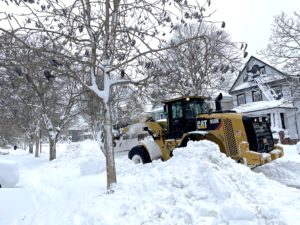Never let a crisis go to waste.
Lake Erie is still not frozen, exposing us to the possibility of additional lake effect storms. The two storms thus far, in November and December, have certainly raised concerns about how such storms are handled. Again. But this time the number of souls lost to the Christmas weekend storm gives the issue a much greater sense of urgency.
The storm was much worse than the Blizzard of ’77 in all respects. There probably will not be a series of Blizzard Balls like those that followed ’77 to commemorate the 2022 event.
All communities struggled to address the health and safety issues of the most recent storm as well as the problems of removing the snow. In Amherst residential streets took a while to get even one pass of a plow. The degree of effort was of course affected by the amount of snow that each community received.
Buffalo always seems to be the last to recover from a storm. There are always the same reasons given about equipment getting down streets and the cars that block their way. It has been the same story for every major storm over the past fifty years or more. Mayor Byron Brown admitted that the city is not prepared to handle blizzards. We sometimes have blizzards.
There are legitimate concerns about the challenges that the city faces, but the fact that they come up repeatedly storm after storm shows that the issue dies until the next storm arrives. Why weren’t there backup generators at warm-up shelters? Why weren’t schools used for that purpose? Why aren’t some basic supplies like flashlights and batteries, food and water, diapers, etc. stockpiled in facilities such as fire halls, police stations, and schools? Why didn’t sound trucks go down the narrow city streets before the storm telling residents to clear at least one side if vehicles couldn’t be taken off the streets? There are dozens of other questions.
There isn’t as much on-street parking in the suburbs as in the city and it is generally prohibited during the winter months, so the issues are not the same. Still, the towns and the county seem to handle snow removal better than Buffalo on both major thoroughfares and residential streets. The county is in very good shape financially and therefore has the resources to buy equipment, plow, and get vehicles removed more expeditiously than in Buffalo.
There should be some serious discussions about metropolitan snow removal. The state needs to be involved too. Political leaders who are not pals still need to work together.
The city has retained the Robert F. Wagner School of Public Service to do a study about what happened and what can be done better. Hopefully that consulting work will serve as a guidepost for reforms rather than a dust collector on someone’s City Hall shelf. The report is due in March. Buffalo, the county, suburban towns and cities if needed, and the state should all be actively involved to produce needed reforms.
Besides the questions noted above, new matters have come to light concerning such things as the low and uncompetitive rates that Buffalo pays private contractors for snow removal, which has encouraged contractors to go elsewhere. The lack of proper equipment to navigate snow-clogged streets and snowmobiles has been noted, as well as the age and unreliability of some of the equipment. Investigative Post’s Geoff Kelly recently reported on the decrepit state of the city’s Broadway Garage, which houses most of the city’s snow-fighting equipment.
Not yet addressed but certainly open for discussion is the question of whether there will be any political fallout from how the storms have been handled. In 1977 the political fallout was significant, contributing to the election of Jimmy Griffin as Mayor and changes in several Common Council seats. Mayor Brown is only in the second year of his fifth term, so there will be no direct political impact on him.
All nine members of the Council, however, are up for election this year. The fact that Council members have been filing many resolutions suggesting and demanding various reforms in the way that the city handles its snow response is an indication that the Councilmen (there are no Councilwomen) are hearing from their constituents and are taking matters seriously.
The city has benefited from substantial grants of funds from the federal and state governments over many years. Recently more than $300 million in federal pandemic relief funds was made available. The Mayor and Council pride themselves on having kept city taxes down for many years. Property taxes are relatively low in the city and of course, no one wants to pay more in taxes. The mayor has suggested that the city is lacking in financial resources to update its storm preparedness.
Problems with inadequate equipment and insufficient funds to pay contractors raise red flags. Like it or not, the Mayor and the Council need to take a serious look at raising city taxes and fees to pay for the things that will leave them better prepared to address future storms.
Four years ago there was an effort to run candidates against incumbents in several Council district. The effort failed mainly because those involved did not take care of the political steps needed to qualify candidates for the ballot. There also wasn’t any particular prominent issue that candidates could focus on. Well, the issues are there in 2023. In a few short weeks we will see if the candidates are too.
Ken Kruly writes about politics and other stuff at politicsandstuff.com
Follow on Twitter @kenkruly
The post Snow and Politics appeared first on Buffalo Rising.

